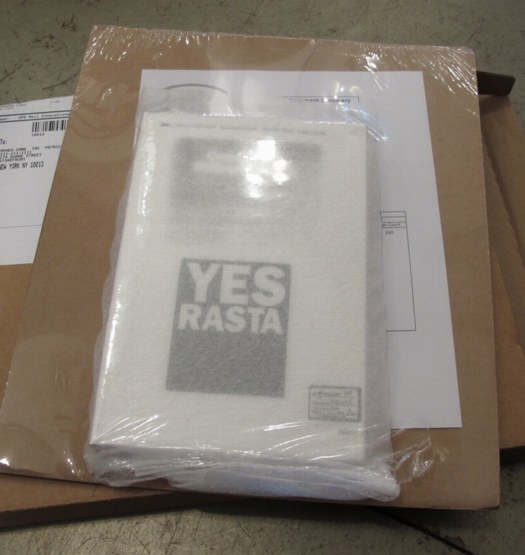
Looks like Monday is Unboxing Day. Whether UPS or USPS, be sure to thank the union members who worked through the weekend to bring you your art nerdy books.
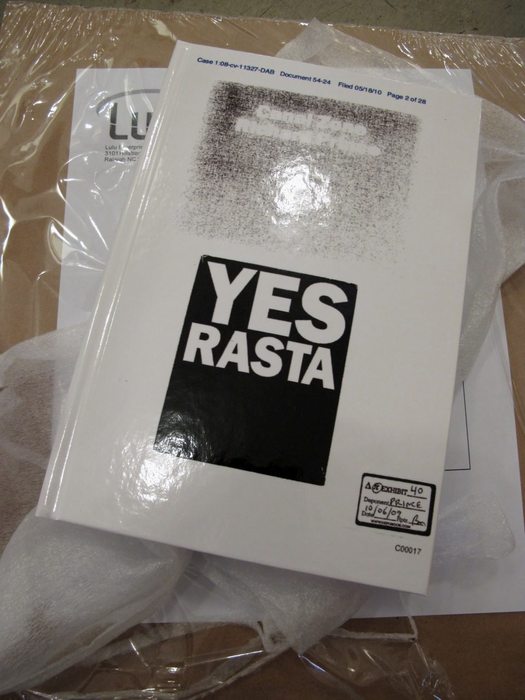
The hardback with the current cover design [updated link, see below] arrived in Mondo Blogoland. I really do like this cover, too. Patrick thinks I should change it back to the softcover version, though, so that his is more collectible. Which is a very generous and slightly hilarious thing to say.
I was also thinking of making a 2-color silkscreen print out of this cover image. Or maybe even a whole portfolio of the Prince v. Cariou exhibits. I tell you, look at Rauschenberg too long, and you’ll want to start silkscreening everything that’s not pinned down.
Oh ho, at Joy Garnett’s studio [below], they staged an impromptu reading of my “conceptual piece.” And now I’m thinking that staging a dramatic re-enactment of portions of the transcript some night could be a lot of fun. Hmm.
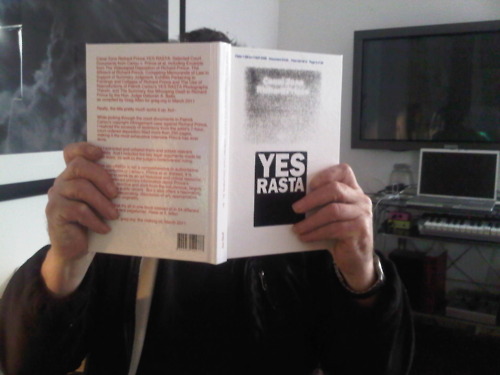
Meanwhile, back at Canal Zone Richard Prince YES RASTA: Selected Court Documents &c., &c. HQ, the champagne mangoes have a new, romantically exotic friend:
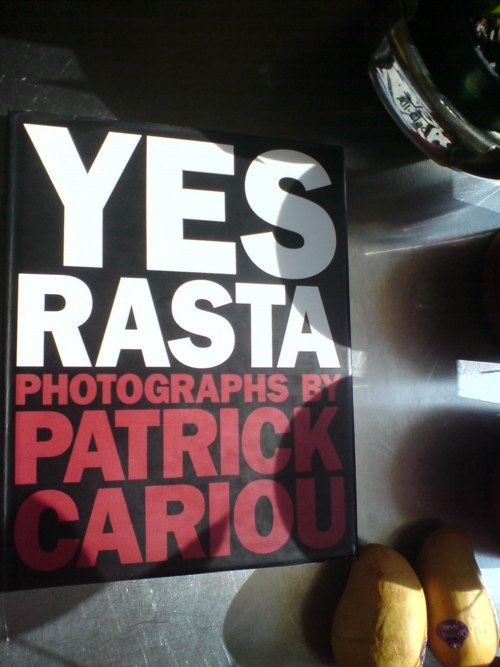
Cariou’s book was apparently supposed to be available as a limited edition, with a signed print. Did not know that. It says it right there on the colophon, though: “A slipcased, limited edition of this book with a signed and numbered artwork by the artist is available upon inquiry; please contact the publisher.”
There’s also a credit to The Small Darkroom, New York for “gelatin-silver prints,” a reference, presumably, to the edition. And there’s a separate ISBN number, 1-57687-074-X, which goes basically nowhere. Which means that Cariou and/or powerHouse had planned to do a limited edition, but it never happened. Wonder why that was? I guess if I were an attorney for someone getting sued for damaging someone’s book and photography market, I might care a little more.
Apr 2011 update: At the moment, the hardcover copy is not available. Here’s a new link to order a softcover copy of the new, expanded edition, which includes Prince’s entire deposition, and additional legal documents.
Category: art
ペプシ館 EXPO’70 Poster
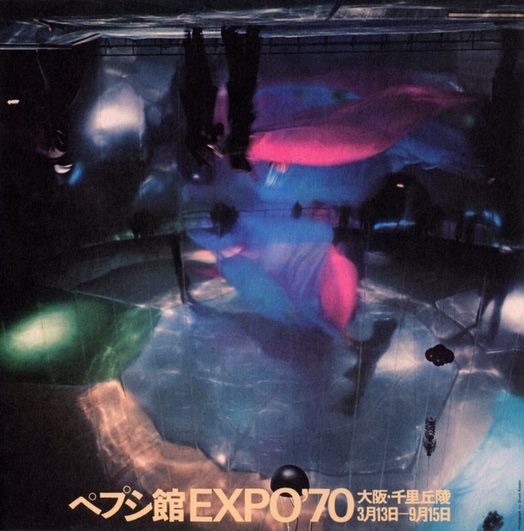
image via Morioka Yoshitomo’s online syllabus of Art & Technology
I don’t collect posters, I really don’t. I just buy some. And then some more.
But when I saw the description of this poster in the Getty’s E.A.T. archive finding aid, I knew I had to add it to the list:
Pepsi Pavilion
printed in Japan, Shunk-Kender photograph of interior of the mirror dome. It shows a rehearsal of the work by Remy Charlip, “Homage to Loie Fuller,” performed at the opening ceremonies. The photograph is printed upside down to emphasize the three-dimensionality of the real image the concave mirror dome produced. Signed by all artist/engineer participants, unnumbered.
Signed or not, I have to track it down.
E.A.T.’s Pepsi Pavilion still kind of blows my mind, several years after I first fixated on it. And it only belatedly occurs to me that though the project was officially a failure, which E.A.T., Kluever, and Whitman were left trying to make the best of, there is a Japanese domestic perspective on it that remains largely unexplored, at least in the English-speaking world. I will have to look into that.
Meanwhile, it’s almost enough to know that the Japanese term for Pepsi Pavilion is ペプシ館, pronounced Pepsi-kan.
Also, Remy Charlip’s “Homage to Loie Fuller”? Do we even have a complete list of all the artists, happenings, programs, and performances that went unrealized when Pepsi cut off the cash?
Also, Shunk-Kender? Those guys really, really got around. Have we already done shows or books or something on them? Art History, I’m talking to you.
UPDATE WHOA, and I have heard back from Art History. At least I got her voicemail. Stay tuned.
Previously: E.A.T. it up: the Pepsi Pavilion at Expo 70 in Osaka
Q. was the Pepsi Pavilion art?
Google Street View’s Shiny Balls
People often ask me, “What is it that makes your Google Street View Art so different, so appealing?”
Actually, no one asks me that, they just send me “Hey, look!” emails with links to Jon Rafman and Michael Wolf. But if they did ask me, I’d probably go off about Bergson and the flaneur’s gaze and Deleuzian notions of cinematic time and the panoptic surveil–
“Hey, look! Shiny object! Want that!”
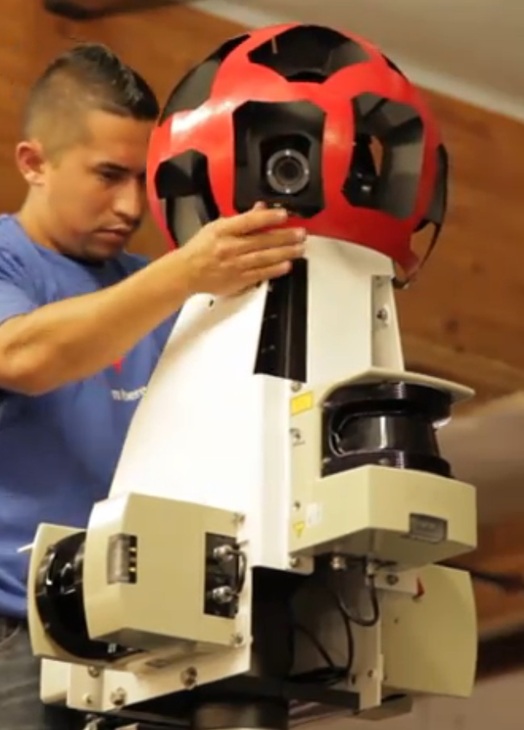
Seriously, chrome that bad boy in an edition of 5, please. I’ll keep the AP.
via Behind The Scenes with Street View [youtube]
Merz van der Rohe
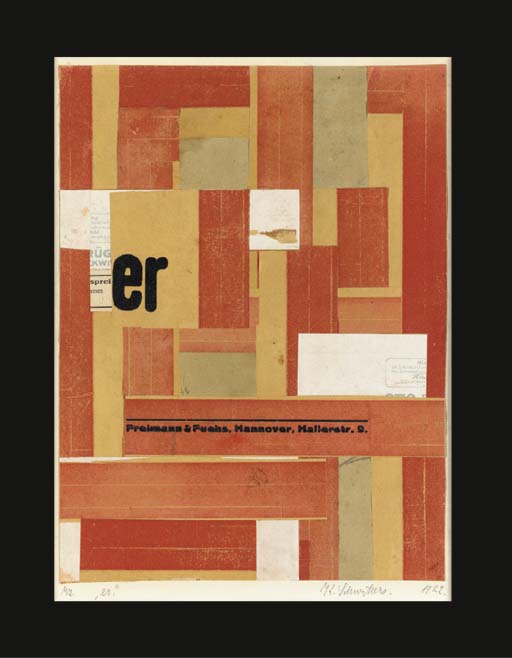
When Kurt Schwitters died in 1948, his lawyer inherited the art the artist had held onto. After his death in 1956, it was dispersed. Sidney Janis bought this 1922 Kurt Schwitters Merz collage, titled er, and then promptly sold it to Schwitter’s friend Mies van der Rohe, whose family held onto it until 2003, when they sold it for £105,650. [christies.com]
So Sue Me, I Think My Richard Prince Depositions Book Looks Awesome
Wow, can I just say that, when combined with the rapid production power of our digitized present, appropriation art is just awesome?
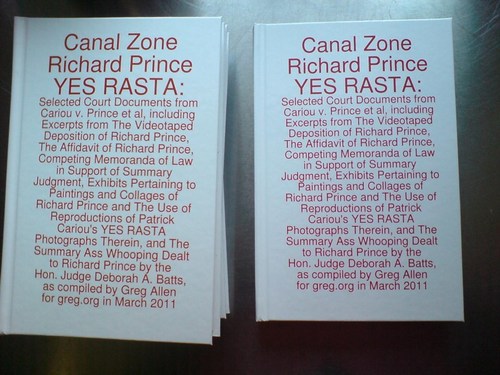
I just got the first hardcover copies of the first version of the book I conceived of a week ago today, Canal Zone Richard Prince YES RASTA: Selected Court Documents from Cariou v. Prince et al, including Excerpts from The Videotaped Deposition of Richard Prince, The Affidavit of Richard Prince, Competing Memoranda of Law in Support of Summary Judgment, Exhibits Pertaining to Paintings and Collages of Richard Prince and the Use of Reproductions of Patrick Cariou’s YES RASTA Photographs Therein, and The Summary Ass Whooping Dealt to Richard Prince by the Hon. Judge Deborah A. Batts, as compiled by Greg Allen for greg.org in March 2011, and it looks rather sweet.
I’m waiting to see a paperback version [updated link info below], and to see the other cover design in person, the one reproducing the court exhibit featuring the photocopied covers of the two dueling books. I like the graphic punch of that one. But I had a hunch, and I’m seeming right, that the original un-design, the full title, laid out in giant red letters [the default setting for the annotate function in Preview, the only software I used to produce the thing] is kind of awesome. So there may be some version tweaking to be done.
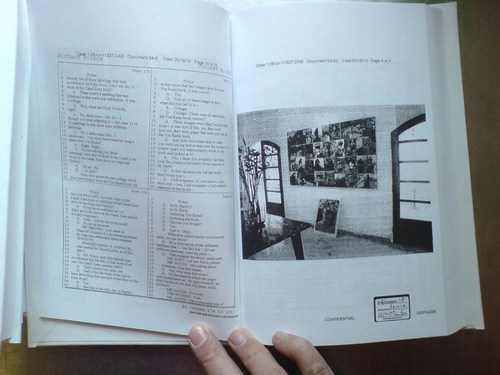
Anyway, the inside is pretty nice, too. The 2×2 deposition transcript pages turn out to read just fine in a trade-size book. Which makes it perfect for the beach or wherever. And it is much thinner than I expected. 290 pages is a lot of content, but it is a pretty manageable-sized book. Also, a little sluttier, frankly. Some of those photocopied PDF’s of Prince’s paintings turn out to be pretty legible after all.
Publishing a book to serve as an indispensable art history reference–and which consists entirely of someone else’s work–should really not feel this fun. But I guess that’s why appropriation’s so hot these days.
UPDATE: Here’s a link to buy the new, expanded softcover edition, which now includes Prince’s entire deposition transcript, plus several other key legal documents. It’s a bit higher quality, too. New printer.
The Sun Never Sets On Your Richard Prince Depositions Shopping Cart
You know what, in my six days as a published author, out there flogging his book, I find myself thinking, again, of Cervantes and Don Quixote. I mean, I it really feels like I’m living in the Quixotian name I gave my film production company, First Sally.
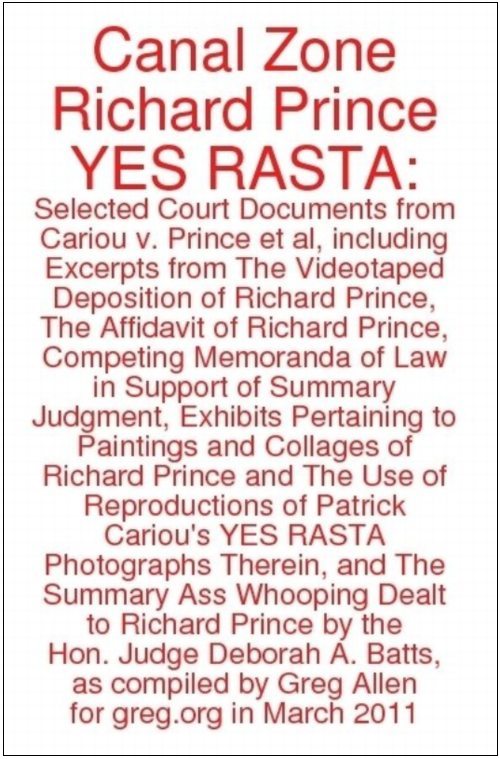
The cover on the paperback edition of Canal Zone Richard Prince Yes Rasta: Selected Court Documents, &c., &c., 290 pages, $16.99
And so as I was reading Jonathan Gharraie’s post in The Paris Review, I couldn’t help but but note all the striking similarities between Canal Zone Richard Prince Yes Rasta: Selected Court Documents, &c., &c., my critically considered selection of Richard Prince’s deposition transcripts and legal filings, and Cervantes’ work. I mean just think about it:
- Both Prince and Quixote mildly shock their guests at exhibits on the Upper East SIde.
- Quixote was recently republished in a carefully crafted illustrated version by a legendary artist press; I carefully assembled the Canal Zone… PDF by hand before uploading it to lulu.com.
- Quixote’s idealistic fantasies are enabled and indulged by an all-powerful Duke for his own bemusement and enrichment; Prince shows–and goes to court with–Larry Gagosian, on whose gallery the sun never sets.
- Cervantes gave his book one of those funny, old-timey, super-long titles; I, well, just look at the cover of the paperback edition.
I could go on and on, to the point I stop debating whether I’m Quixote or Cervantes, and begin wondering whether I’m Pierre Menard or Borges. I assume all authors go through this.
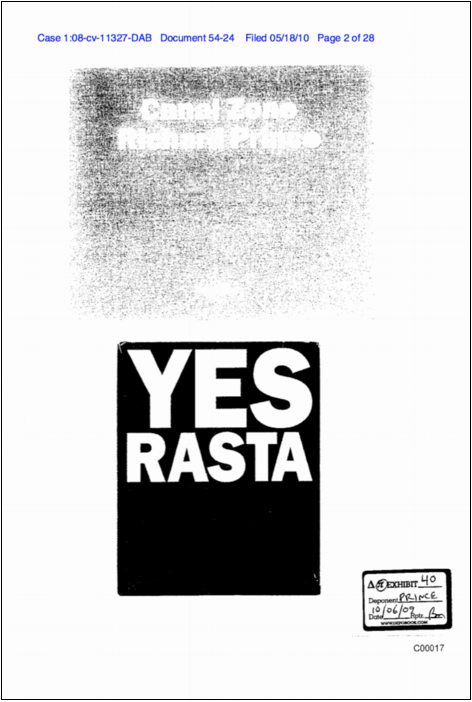
Canal Zone Richard Prince Yes Rasta: Selected Court Documents, &c., &c. in hardcover, 290 pages, $24.99 [updated link, see below]
More info on Canal Zone Richard Prince Yes Rasta in the original post.
See a couple of sample spreads from the electronic edition.
Anyway, Gharraie sums up nicely the digital future where artisanal books still thrive in a tablet world:
If anything, I would rather have it both ways: the book and the blog; the lavish endeavor of the lovingly prepared new edition and the take-out convenience of the virtual text.
And I humbly announce that the future of both art and literature is here. Now if you’ll excuse me, I have to get to work on my book trailer.
APR 2011 UPDATE: The hardcover is temporarily unavailable, but there is a new, expanded softcover edition, which now contains Prince’s entire deposition transcript, an additional 101 pages, plus other key legal documents. Also, it’s from a new, nicer printer.
On The 2nd Through 8th Tatlin’s Monuments To The Third International
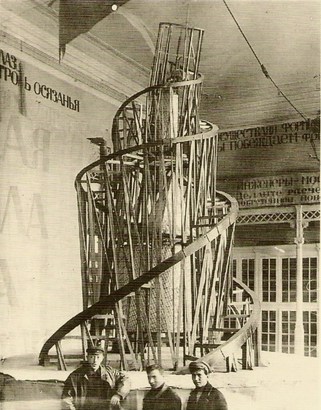 So I’m slowly making my way through the 35-page press release [!! those were the days, right?] for MoMA’s 1968-9 exhibition, “The Machine As Seen At The End Of The Mechanical Age,” which included a long-lost, recently stumbled-upon in a Tempe, Arizona shed, Dymaxion Car, and curator Pontus Hulten’s freshly researched and replicated magnum opus, a life-size model of Vladimir Tatlin’s 1920 Monument To The Third International. Some choice excerpts on the remaking of:
So I’m slowly making my way through the 35-page press release [!! those were the days, right?] for MoMA’s 1968-9 exhibition, “The Machine As Seen At The End Of The Mechanical Age,” which included a long-lost, recently stumbled-upon in a Tempe, Arizona shed, Dymaxion Car, and curator Pontus Hulten’s freshly researched and replicated magnum opus, a life-size model of Vladimir Tatlin’s 1920 Monument To The Third International. Some choice excerpts on the remaking of:
Work was based on only four photographs (a crucial one was discovered during the process), a few drawings, some written descriptions and information from the sole living assistant of Tatlin. Troels Andersen, Ulf Linde and Per Olof Ultvedt of the Stockholm Academy of Art prepared a small wooden working model. From this, carpenters Arne Holm and Eskil Nandorf built the reconstruction, which is 15 feet 5 inches high, about the same size as Tatlin’s.
The research and reconstruction took about a year. The tower was first exhibited in the Tatlin show at Moderna Museet in Stockholm last summer. It was shipped to the United States in nine crates and reassembled by Mr. Nandorf in the Museum Garden.
So many interesting things here. Andersen had been working with T.M. Shapiro, part of a group called the “Creative Collective,” which included Tatlin, who made the first Monument in 1919-20, to document and resuscitate [to use Nathalie Leleu’s term] the neglected/suppressed history of the Russian Avant-Garde. In the catalogue, Hulten wrote, “For the first time, it seemed possible that an artist-engineer materializes the synthesis of architecture and sculpture.”
Leleu took a detailed look at contemporary curators’ use of refabrications and replicas; the excerpt dealing with reconstructions of Tatlin’s Monument was published in 2007 by Tate Papers.
She notes how Hulten was “a major protagonist in at least two of these reconstructions,” the first at Moderna Museet in 1968, and then at the Pompidou in 1979 for his historic show, Paris-Moscow. The Paris model was substantially different from the Stockholm model, Leleu writes, in part because Shapiro had recovered additional notes and rebuilt a Monument himself in 1975, but also because by 1979, Hulten was able to access original Tatlin materials in Russian museums and archives which had previously been blocked.
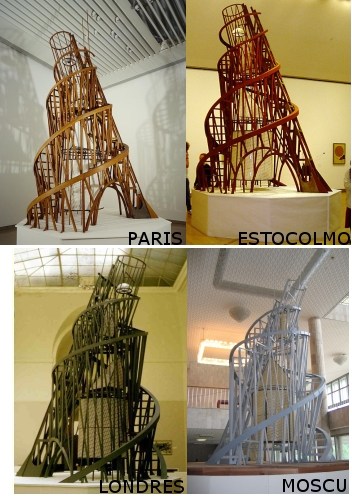
In fact, because of last-minute denials of key loans by Soviet officials, Hulten’s show in 1968 consisted entirely of reconstructions, which led Hulten to dub his show “conceptual.” As it happens, this whole Tatlin saga and the fabrication of the Monument, was unfolding while the Moderna Museet was showing Andy Warhol’s work–including the Brillo Boxes, which would eventually become the subject of their own refabrication controversy.
It’s almost as if, while showing the dominant, if controversial, figure in American art, Hulten was simultaneously constructing an alternative to the arc of modernist and postwar art history. With an emphasis on the constructing, I guess.
Anyway, after an insurance dispute, the Parisian fabricators ended up making a new, Paris-style Monument for the Moderna Museet, and then consulting, along with Hulten, on the fabrication of additional Monuments in Moscow, one in London, and one in Los Angeles.
Maybe it’s clearer in her fuller paper, but in the Tate excerpt, Leleu refers to a “reconstruction project…in Washington,” which I think is actually the model built by USC Architecture School students for Maurice Tuchman’s LACMA 1980 exhibit, “The Avant-Garde in Russia,” which later traveled to the Hirshhorn.
The Model of Vladimir Tatlin’s Monument to the Third International: Reconstruction as an Instrument of Research and States of Knowledge [tate papers 2007]
What Did People E.A.T. In 1971?
I recently found a poster for a Pontus Hulten exhibition at Moderna Museet called “Utopier & Visioner, 1871-1981,” which I think may have come from Billy Kluver’s own collection.
There’s not much information online about the show with that title, but the Getty mentions it; they hold the archives for E.A.T., the art & technology collaborative Kluver founded with Rauschenberg and Robert Whitman.
Turns out “Utopier & Visioner” was the site of one node in E.A.T.’s project, Telex: Q&A, an early attempt at networked communication. E.A.T. set up public telex machines in Stockholm, Tokyo, New York [at MoMA] and Ahmedabad, India, and invited people to ask each other questions. Hulten’s show provided the theme; the dates in the title referred to the Communards and to imagining what the world would be like ten years into the future.
1
Questions about the future would be daisy-chained along to the different venues to give people a chance to read and respond. [The connections were not real-time; data was only transferred 10 minutes/day.] And to prime the pump, “wise men” in each city were invited to offer their answers as well.
E.A.T. was planning to publish the resulting conversations, but I can’t see that they ever did. The Getty has several folders stuffed full of telex strips collated into roughly chronological order. It might be interesting to look through them.
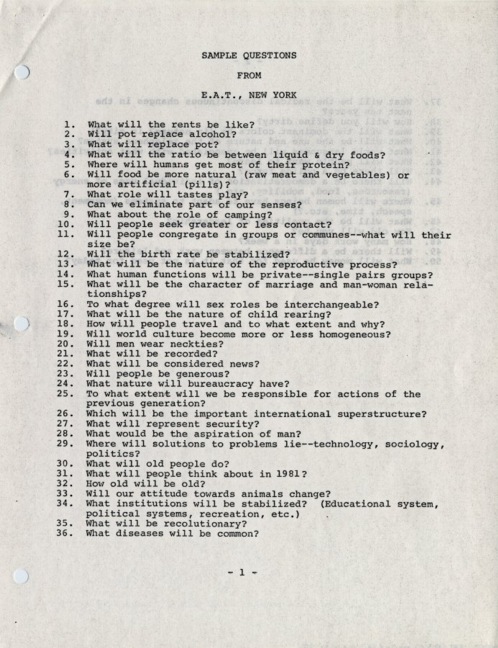
Or maybe, uh, not. The Daniel Langlois Foundation in Quebec has digitized some materials from E.A.T.’s archives, including the original press release for Telex: Q&A, which contains sample questions:
1. What will the rents be like?
2. Will pot replace alcohol?
3. What will replace pot?
4. What will the ratio be between liquid & dry foods?
6. Will food be more natural (raw meat and vegetables) or more artificial (pills)?
20. Will men wear neckties?
24. What nature will bureaucracy have?
29. Where will solutions to problems lie–technology, sociology, politics?
49. Will there be a difference between work and leisure?
Maybe I do want to know Kenzo Tange’s opinion on neckties, but frankly, it’s almost interesting enough to think that in 1971, people were seriously expecting dramatic changes would sweep through society. I mean, sure, Twitter and all, but still. Pills!
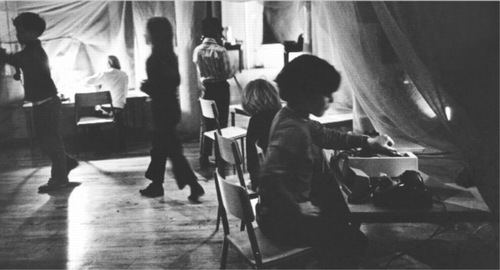
Telex: Q&A was closely related to another E.A.T. project in 1971, Children and Communications. Led by Robert Whitman, E.A.T. set up kid-sized labs in the various boroughs of New York, and connected them via fax and telex, and let kids loose in them to communicate with each other.
Langlois has some of those documents up, too; it’s kind of hilarious, in that except for a tictactoe game, and an attempt at an exquisite corpse-style story, most of the interaction is about the interaction itself. Just like Thaddeus S.C. Lowe’s first telegram from a balloon to like 90% of cell phone calls today [“I’m calling from the train.”] My favorite is this drawing, which pretty much sums it up, a screen asking the kid, “Who do you love?”:
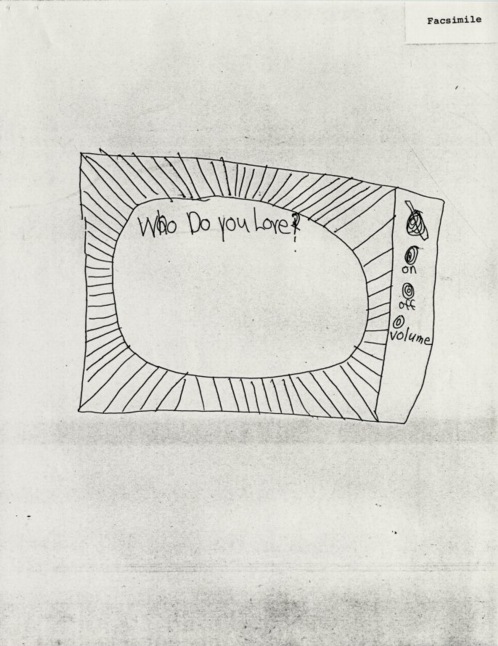
Related, interesting: Tokyo Terminal documentation for Telex: Q & A [fondation-langlois.org]
Size Matters?
As I have tried to make sense of the Cariou v. Prince decision, to figure out how Judge Batts found it so easy to dismiss Prince’s detailed explanation of his transformative ideas and process, I can come up with two possible rationales.
One is the distinction absolutely no one except Prince–Cariou, the judge all the lawyers, including Prince’s and Gagosian’s–makes between photographs and images, reproductions in a book. It’s one of Prince’s consistencies that reveals itself throughout his deposition and affidavit. [Always be selling!]
And it’s a point that Joy Garnett makes very cogently in her editorial in artnet which looks at the difference between mass produced images and fine art objects.
The very existence of Prince’s “Canal Zone” series is apparently now in peril, in part because no one seems to be able to tell the difference between a painting, which is a one-of-a-kind object, and a photograph, which is by definition mass-producible.
The other distortion I see is scale. Patrick Cariou and his lawyers prepared an exhibit [it’s in the book, $25 hardcover, $16 paperback!] detailing all the Yes Rasta images Prince used, in whole or in part, as source material in his paintings.
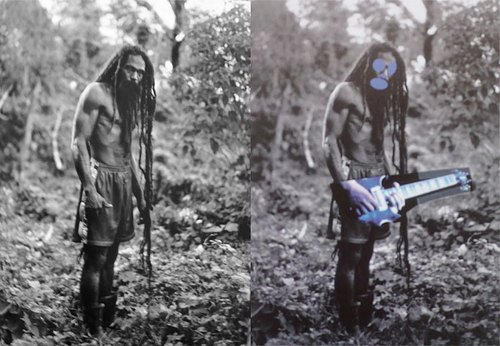
Photocopied side by side, the book pages and paintings can seem remarkably similar, even interchangeable. The comparison images that Cariou and friends released to the press are even more persuasive. But if this isn’t technically deceptive, it certainly obscures the scope of Prince’s transformations.
Cariou’s book is 10×12 inches. Prince’s paintings are 6-12 feet. Graduation, the painting made by altering the coloring of Cariou’s image, reprinting it, painting and collaging it, rescanning it, cropping it, inkjet printing it onto canvas, and then overpainting and collaging it again, is 5×6 feet. A more accurate side-by-side comparison would look like this:
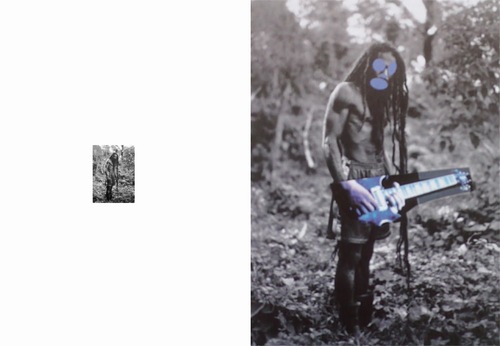
These details of size, color, cropping, and format might seem like minutiae. But they are also exactly the kind of transformational changes cited by the judge in Blanch v. Koons. More importantly, they map directly to the decisions Cariou used to describe his own creative process–and they were also cited by the judge in declaring Cariou’s work “highly original.”
Maybe if the judge had compared object to object instead of image to image, she might have found Prince’s efforts a little more worthy of copyright consideration. In their filings, Prince and his lawyers repeatedly invited the judge to view the paintings themselves, either in Prince’s studio, or in a gallery or other space in town. It does not appear that this happened. But maybe she looked at Cariou’s exhibit, and figured she didn’t need to see anymore.
That’s So Great! The Andy Andy Monument
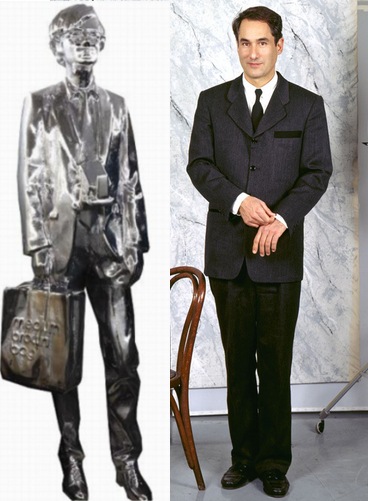
We know that Rob Pruitt made the chromed fiberglass figure for The Andy Monument by bodyscanning his friend and collector, the Cincinnati former car dealer Andy Stillpass.
But am I the only one who thinks the sculpture’s face, too, looks more like Stillpass than Warhol?
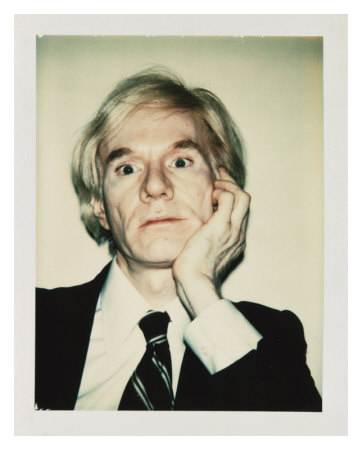
And it IS called The Andy Monument, not The Warhol Monument.
Anyway, that is awesome. Or as Andy [Warhol] would’ve said, That’s so great! Andy deserves it!
Stillpass image on right: modeling his Andrea Zittel Uniform, 1993 like I said, awesome. [zittel.org]
OG Fujiko Nakaya Fog Sculpture
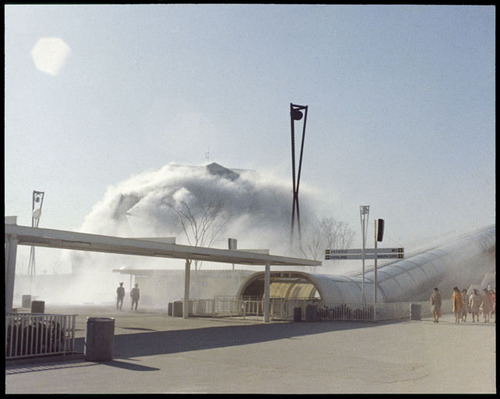
I may be too late to see the Getty Research Institute’s exhibit on postwar Japanese art, but I think it’s also past time I hotfoot it out there and start digging through the E.A.T. archives.
If there are more photos like this of Fujiko Nakaya’s fog sculpture at E.A.T.’s Pepsi Pavilion at the Osaka ’70 expo, I should be booking my study carrel right now.
Pepsi Pavilion with Fog Sculpture, Japan World Exposition ’70 [getty.edu]
From The Department Of Corrections: Archivists Do Not Find My Anecdotes Amusing
I guess if you think about it, archivists really wouldn’t think it’s exciting, or even that amusing, when you tell a story that wrongly makes it sound like they’ve been taking smoke breaks for 25 years, leaving their random blogger patrons to discover lost art treasures under their noses.
But that is apparently how my post a couple of weeks ago about opening an unprocessed box of archival material from the Alan Solomon papers sounded to Barbara Aiken, the Chief of Collections Processing at the Smithsonian’s Archives of American Art.
Fortunately, she was kind enough to correct my errors, chief among which is the implication that the box I found some Jim Dine drawings in had not, in fact, been sitting unprocessed in the Archive for 25+ years; it only came in in 2007, and they are, in fact, getting to it.
On this error and the larger issues of archive processing and of artworks inside the archives, Ms. Aiken graciously sets me aright, and for that I thank her and her most professional, capable colleagues.
Previously: from the mixed up files of basically everyone [except the people who leave their papers to the AAA, where they are very well looked after and made accessible]
The Drawing Machine As Seen At The Beginning Of The Digital Age
Before I talk about Microworld, the 1976 industrial film made for AT&T by Owen Murphy Productions, let me just state the obvious, and get it out of the way:
We are long, long overdue for a comprehensive, scholarly retrospective of William Shatner’s spoken word pieces. The mandarins who keep our cultural gates should not be able to just drop a masterpiece in our laps on their own whim, not we who have known “Lucy In The Sky With Diamonds” for decades. I give you three months, and if I don’t see any movement, I’m taking the curatorial matters into my own hands.
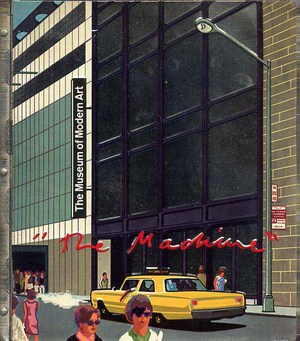
OK. Microworld. Holy crap, who made this thing? Owen Murphy Productions, who made several other films for Bell Labs over the years, including Incredible Machine (1968) which screened as part of the film program [PDF] at “The Machine As Seen At The End Of The Mechanical Age,” Pontus Hulten’s 1968 exhibit at The Museum of Modern Art. [that’s the show with the exhibition catalogue with the crazy, stamped metal cover.] Owen Murphy probably needs his/their own retrospective, too.
[11/2011 UPDATE: Thanks to Robin Edgerton, who has been working on the AT&T film archive, for pointing out that the correct title was Incredible Machine, not The Machine, as MoMA’s press release had it. You can watch Incredible Machine online.]
That will give us a chance to appreciate the backlit photomurals
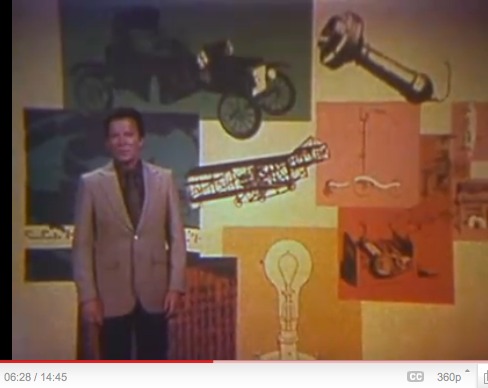
and the rather incredible prop circuitboard dioramas. [I left the timestamps in for easy reference.]
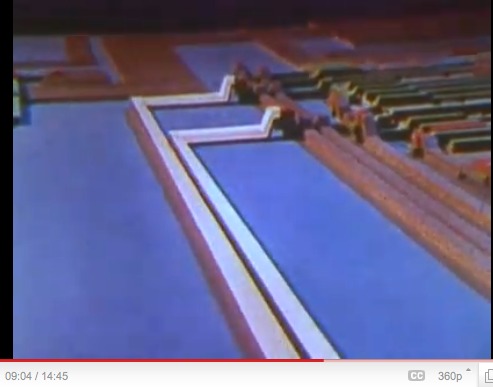
Shatner marvels for us at the minute intricacy of circuitboards reduced to eye-of-a-needle-sized microchips. Microchips which are apparently still designed in large-format, paper schematics.
Which are drawn. With a pen. By a [computer? punch card? stencil?] controlled mechanical printer.

Holy crap, people, this is a drawing.
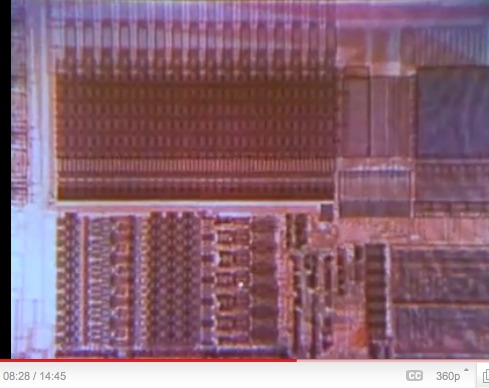
Turned into a backlit transparency, but whatever. A DRAWING.
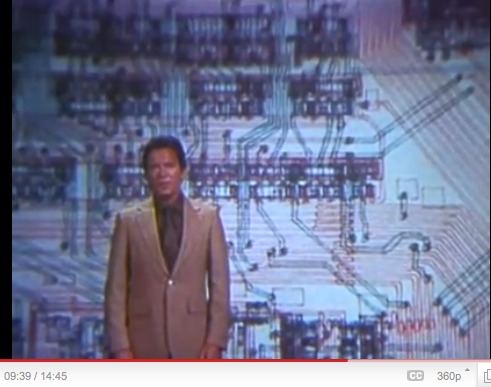
Jean Tinguely’s Metamatics drawing machines, we know. Olafur Eliasson’s studio folks set up that acoustic drawing machine at Tanya’s in 2008. [Wasn’t there also a thing with pulleys that drew on the wall? Who was that?]
Anyway, just saying, there are–or were–amazing drawing machines creating amazing, massive drawings, in the service of America’s most advanced scientists and engineers–who apparently didn’t bother keeping them? Where are they? What are/were they? Do any survive? What else could they be used for? I think I must find the answers to these questions.
UPDATE: ASKED AND BEGINNING TO BE ANSWERED
Thanks to Beau [aka @avianism], who points me to pen plotters and their adaptation and creative deployment, apparently in the last few years, by artists such as Douglas Repetto, whose drawing below, is part of the chiplotle group on flickr.

Chiplotle is a Python library created by Repetto and Victor Adan at the Columbia University Computer Music Center which allows you to code for and operate pen plotters from a laptop. The future of the past is here.
UPDATE UPDATE And whaddya know, via @johnpyper, there is a show of the Spalter Collection of computer code-generated art right now at the deCordova in Lincoln, MA, which includes, of course, Stan VanDerBeek, who worked on early animation and computer graphics languages at Bell Labs.
And Now For Something Completely Different
Enough Prince! Let’s talk about someone else! Richard Serra, for example.
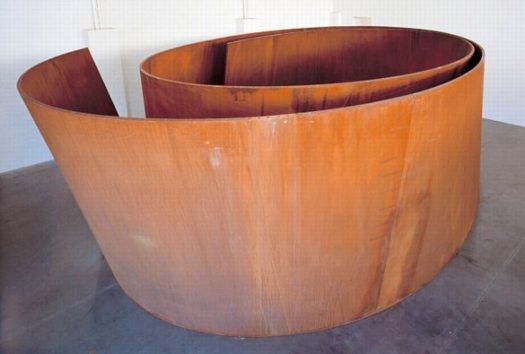
Bellamy, 2001, Richard Serra, image via gagosian.com
Did you know–I did not, which is why I am kind of fascinated to mention it here–that one of Richard Serra’s early torqued spiral sculptures, Bellamy, from 2001, was traded for…for three Richard Prince Canal Zone paintings?
Continue reading “And Now For Something Completely Different”
Canal Zone Richard Prince YES RASTA: Sample Spreads
Thanks for the support and feedback on the Canal Zone Richard Prince YES RASTA: Selected Court Documents &c., &c. book. [updated link info below]
Some folks who ordered the electronic version–the first to get the compilation in their hands, since the print editions take a few days to arrive–have emailed wondering where “the rest” of Richard Prince’s deposition transcript is, because there are gaps and missing pages.
That’s exactly right, and it’s why I decided to make this thing in the first place. As far as I can tell, the entire 378-page transcript of the 7-hour deposition was not entered into the court record, only the excerpts that pertained to quotes or points referenced in the two sides’ various legal motions. As I was reading those scattered snippets in various places in the court record, I realized it would be more useful to have a single compilation of all Prince’s testimony. And it’d be easier if it was in order. So I took apart the pdfs and sorted the pages, then interlaced the other exhibits [i.e., images from Cariou’s book and Prince’s show and catalogue] as they came up in the course of testimony.
Here are a couple of sample spreads taken from my original [sic, heh] pdf. There are about 250 of these transcript pages in total, four per printed/pdf page.
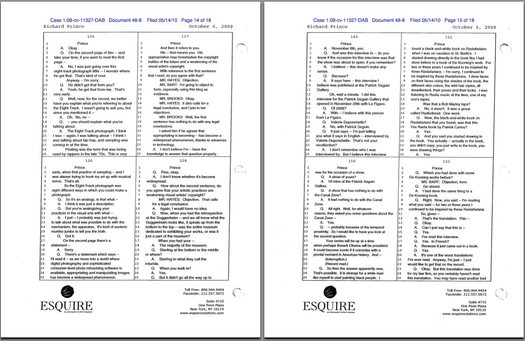
pp. 125-8, 149-152
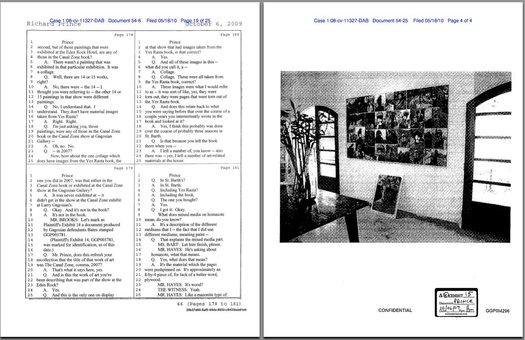
pp. 178-181 and Exhibit 15, installation shot at the Eden Rock Hotel, St. Barth’s
APR 2011 UPDATE: Here is the link to buy the new, expanded edition, which includes Prince’s entire deposition transcript–an additional 101 pages–plus other key legal documents. It’s a new printer, and the finish of the book is nicer, I think.
